Clan Focus – The Phoenix
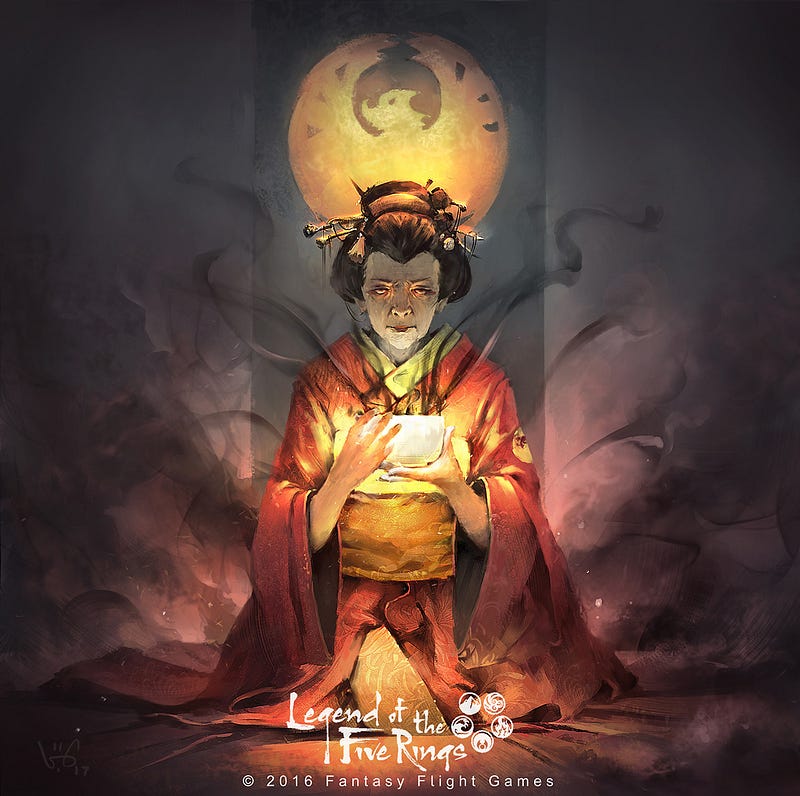 Isawa Atsuko by Le Vuong
Isawa Atsuko by Le Vuong
The Phoenix clan pose somewhat of a mystery to Rokugan. As devoted pacifists, they are an easy target for clans who would seek glory in war, but if roused, their powerful Shugenja and mastery of the elements can devastate even the strongest army. They are a clan of great power and wisdom, but sometimes arrogance and hubris.
Fantasy Flight Games have recently released spoilers of the Phoenix clan cards from the upcoming core set so we have another review of the clan cards. This time veteran Phoenix player Justin Walsh has helped out and given some of his insight for this article.
Phoenix Clan Mon
Stronghold
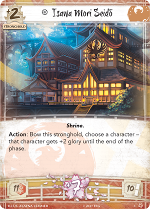
The Phoenix Clan stronghold, Isawa Mori Seidō has +2 province strength, 10 influence, and 7 fate production. It has 11 honor, on par with the Crane and Dragon Clan strongholds, and just below the Lion’s 12. The stronghold can bow to give +2 glory to any character, including one of your opponent’s. If this targets an honored character, it will give them a +2 military and +2 political skill boost. Conversely, if this targets a dishonored character, it will give them a -2 military and -2 political skill penalty. Targeting an opponent’s dishonored personality, however, does carry some risks. If they can re-honor and then honor that personality, you will have given them a +2/+2 skill bonus with one of your actions!
A strategy that honors and boosts your own characters should be more straightforward and safe, but it’s still worth noting the control options that this stronghold presents. Therefore, at least some balance in methods of honoring and dishonoring personalities may be desirable. Finally, the stronghold will allow you to contest the imperial favor much more strongly than other clans. By boosting the glory of one of your ready characters after the conflict phase, it is almost certain the Emperor will grant you his blessing.
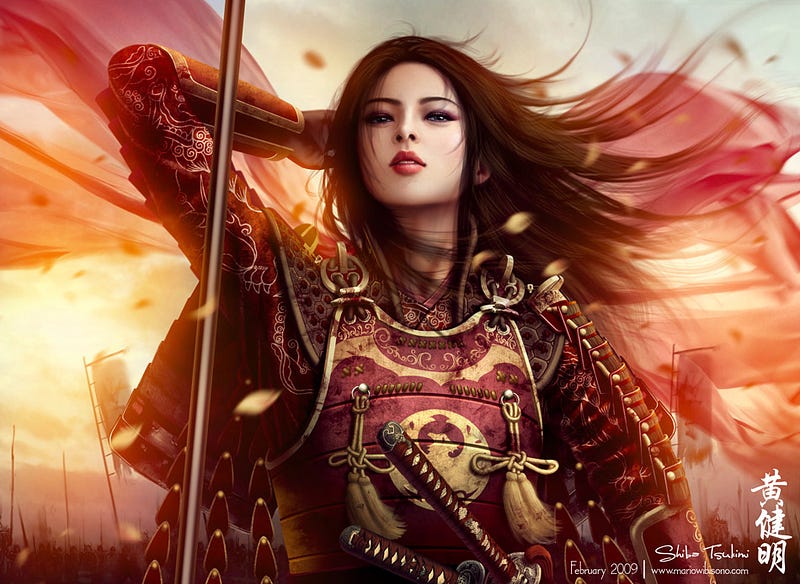 Shiba Tsukimi by MarioWibisono
Shiba Tsukimi by MarioWibisono
A review of the new Phoenix Clan cards revealed a few core themes that seem to sum up the Clan’s play style. The Elemental Rings are a big feature, followed by Glory and Honor, with the smaller themes of Pacifism and Shugenja and Bushi rounding out the card set. These themes give the Phoenix clan with a great amount flexibility in how they want to play their game and defeat their opponent.
The Elemental Rings
Attuned to the Elements
Contained within the Phoenix Clan’s core set of cards is a group of five Shugenja who interact with the elemental rings. These aren’t the elemental masters of the story, but they do represent a defining aspect of the Phoenix Clan’s identity. Each of these five cards has an ability that can only be used when a certain ring has been claimed, or to effect a contest of a given elemental type. This is a double-edged sword, granting the Phoenix some exceptionally powerful abilities which are nonetheless limited to very specific scenarios. Part of the Phoenix Clan’s strategy, then, will be to set up such scenarios to take full advantage of these elemental abilities. The presence of these characters can have a significant impact on how each player plays, and may cause opponents to avoid specific rings altogether.

Solemn Scholar is a 1-cost Shugenja with 1 military skill, 1 political skill, and 1 glory. Solemn Scholar’s ability requires you to have the Ring of Earth in your claimed pool. Earth is not an often-claimed ring, but Know the World does allow you to cheat it in at a pinch. The Solemn Scholar does not need to bow to use its ability, meaning it will be able to attack or defend as needed while keeping its action available at all times. However, the effect must target an attacking character.When combined with the requirement of having the Ring of Earth in your claimed pool, this means the Solemn Scholar’s ability will not be available during your opponent’s first attack when they are the first player.

Adept of the Waves is a 2-cost Shugenja with 2 military skill, 2 political skill, and 2 glory. His action gives a target character covert if that character is assigned to a water conflict. Covert provides the following to a character who has it: “When this character is declared as an attacker, you may choose a character that does not have covert. That character cannot be declared as a defender for this conflict during the ‘declare defenders’ step.” As the Adept’s ability is an action, not a reaction, it needs to be used before the conflict is declared. Given that a number of Phoenix cards significantly reward the winning of conflicts, the Adept’s ability can represent a powerful threat. To counter this, a first-player opponent could try to negate the Adept’s attacking advantages by choosing the Ring of Water for their first conflict. By doing this, an opponent might negate the Adept’s ability to decisively swing conflict assignments but might also lose out on a ring stacked with fate, or another, equally important ring.
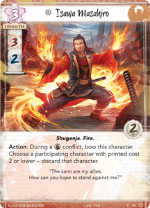
Isawa Masahiro caused a lot of excitement when he was first revealed. During a fire conflict, he can bow to discard a participating character that costs 2 or less fate. He doesn’t care how much fate may be stacked on that character, or how many weapons and attachments that character might have. Masahiro does not even need to participate in the conflict: he can use his ability from home. However, his ability can only be used during a fire conflict, meaning your opponent can blank Masahiro by not choosing the Ring of Fire, forcing you to declare it for yourself. Thankfully, with the Phoenix Clan’s focus on glory, declaring fire conflicts is something you should be generally happy to do, and there are a couple of province cards, like Elemental Fury and Kuroi Mori, that can turn a conflict at their province into a fire conflict.
Masahiro has to bow to use his ability, so, in using that ability, you are deciding that your own 3-Fate cost, 3 Military, 2 Political character is worth less than what you’re discarding. So, if you make Masahiro with no additional Fate, then use his ability to discard an Obstinate Recruit with no stacked fate or attachments, the chances are you’re making a horrible mistake. Finally, given that Masahiro’s effect can only target participating characters, your opponent could choose to leave all the 2-cost characters they value at home during a Fire conflict. If that’s the case, though, Masahiro has effectively removed them from that conflict without doing a thing.
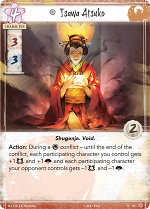
Isawa Atsuko is a 4-fate Shugenja with 3 military skill, 3 political skill, and 2 glory. Atsuko’s action ability can only be used during a void conflict, but alters the very fabric of reality for that conflict’s duration. Until that conflict ends, all your participating characters get +1/+1, and all participating characters the opponent controls get -1/-1. With one character on each side, that’s a 2-point swing, and the bigger the conflict, the bigger the swing. The ability does not require bowing, so Atsuko will still contribute her skill while participating, and she can also use her ability while bowed. Decks dedicated to a swarm strategy, like many Lion Clan builds, will not enjoy seeing Atsuko on the table.
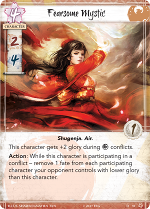
Fearsome Mystic is a 4-fate, 2 military skill, 4 political skill, 1 glory Shugenja. Unlike the other elemental characters, the Mystic’s ability is useable in any conflict and removes 1 fate from each opposing character with lower glory. The Mystic has 1 printed glory, so, in a vacuum, her ability will only affect 0-glory characters. However, during an Air conflict, the Mystic gets +2 glory. And with the stronghold ability, the Mystic can get another +2 glory, potentially reaching 5 glory! The effect itself isn’t going to win a conflict, but it could wipe your opponent’s characters clean of fate, creating a massive board swing on the following turn.
It is also worth noting the Fearsome Mystic’s synergy with the Seeker of Knowledge. While attacking, the Seeker of Knowledge makes every conflict an air conflict in addition to its normal type. The Seeker of Knowledge is also a conflict character, meaning she can be played from hand. This means that defending against a Fearsome Mystic while a Phoenix player has 2 fate available could see a giant fate-wipe for all defending characters. Be careful.
 Isawa Tadaka by Diego Gisbert Llorens
Isawa Tadaka by Diego Gisbert Llorens
Manipulating the Rings
To support these abilities, which depend on certain rings, the Phoenix have a suite of cards that focus on ring manipulation. They can switch claimed and unclaimed rings, make the current conflict count as a specific type of ring or change that ring entirely – and even deny an opponent the ability to declare a given ring for an entire turn. The other clans may make use of the elemental rings, but only the Phoenix have mastered them.
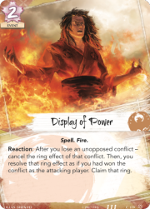
Display of Power is a reaction to losing an unopposed conflict. It costs 2 fate. Because the conflict must be unopposed, it also contains a hidden cost of 1 honor (because you had no one present at resolution), and only works when you are defending. This also means there is a significant chance your opponent broke your province. So, with all these costs and conditions, this card has to do something pretty powerful, right? Well, it does. It cancels the effects of the ring your opponent was trying to claim. Then you claim that ring, and resolve its effects instead. Timing will be everything with this card, which is capable of producing enormous blowouts. Your opponent has committed characters to win a conflict, and leaves that conflict with all those characters bowed, a critical ring effect reversed, and the Phoenix player likely following up with a conflict of their own.

Know the World takes a lower-key approach. For 1 fate, you can switch a ring in your claimed pool with a ring in the unclaimed pool. So, if you win your first attack and claim the Ring of Void, triggering its effect to remove a fate from an opponent’s character, you could, before your next opportunity to attack, pay 1 fate to switch the Ring of Void back into the unclaimed ring pool, allowing you to declare your second attack as a void conflict again! The limitation here is that you already have to have claimed a ring. Most of the time, this will mean you’ve won a conflict while attacking. But, with Display of Power, you may have snagged one from your opponent. Know the World can also function as an economy card and fate denial for your opponent. If a ring is stacked with one or more fate, you can use Know the World to take that ring before your opponent can declare a conflict and take its fate themselves. If a ring has 1 fate on it, Know the World effectively costs 0; if a Ring has 2 or more fate, then you are gaining fate. This means that Know the World also lets you focus on the rings you really want to use, rather than the rings which are fate-effective. However, Know the World does not let you alter the ring in a current conflict, as a contested ring is in neither the claimed nor unclaimed pools.
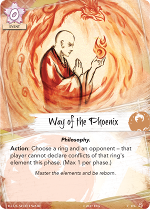
Each of the Ways has been defining for their clan. The Way of the Phoenix is both subtle and complex, with an ability that can swing games, but which will be incredibly difficult to master. It allows you to choose a ring and prevent an opponent from declaring conflicts with that ring’s element for the rest of the turn. On a turn where the opponent has priority, the Phoenix can deny them their first choice of ring. On a turn where the Phoenix has priority, they can be assured two rings of their choice. Both these scenarios can represent powerful tempo plays. But Way of the Phoenix also functions as an economy card. Because you can deny your opponent access to a given ring, you can guarantee that it will stack 1 fate at the end of the turn by not taking that ring yourself. If a ring already has 1 or more fate, you can deny an opponent the option to take that Ring and claim its fate for yourself. Or, if you’ll be the first player on the following turn, you can make sure that a ring will stack to 2, or even 3 Fate! The vast utility of this card is perhaps its greatest weakness. Knowing how and when to best employ it will test even the very skillful.
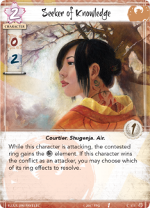
When she was initially revealed, the Seeker of Knowledge gained a lot of attention from players interested in honor running. At 2 fate for 0 military and 2 political skill, this conflict-deck character isn’t very skill-efficient. But the reason she’ll be played is her ability. While the Seeker of Knowledge is attacking, the conflict also gains the air element. This means that you can trigger the Ring of Air effect, even if the Ring of Air has already been claimed by you or your opponent this turn. Looking at the Seeker of Knowledge, you have to ask, ‘Is 2 Fate and a card from hand worth 2 political skill and 2 honor?’ Given how hard it is to generate honor in the game, the answer has to be yes. The distance from a starting honor of 11 to the goal of 25 is a struggle to traverse, and triggering the Ring of Air effect just once with the Seeker of Knowledge will get you 1/7th of the way to victory. The Seeker can also power up the Fearsome Mystic on attack, giving her +2 glory to help use her ability.
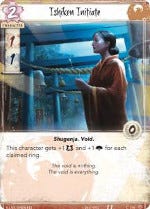
The Ishiken Initiate is a simple, no frills conflict character for 2 fate. At the start of the turn, she will have 1 military and 1 political skill. For the last conflict, she could very well have 4 military and 4 political skill, assuming all three previous conflicts ended with a ring being claimed. While a 1/1 for 2 fate is poor, a 4/4 for 2 fate is very strong. This character also has the Shugenja trait, which other cards can key on.
Isawa Ikariya by Shen Fei
Pacifism
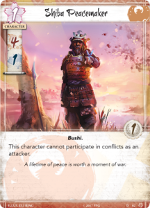
At 1 Fate for a 4 Military skill Bushi, the Shiba Peacemaker is one of the most efficient characters we’ve seen so far. Unfortunately, this comes with a restriction: the Peacemaker cannot participate in conflicts as an attacker. That said, whenever your opponent declares a military conflict, the Peacemaker is going to earn its keep. There is a case for playing Cloud the Mind on the Peacemaker, to remove its limitation and allow it to attack, but this will always be a situational play. Often, the Peacemaker is going to get the job done as a big defender who just makes life harder for your opponent.
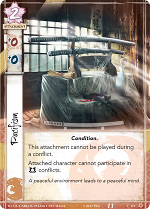
For 2 Fate, Pacifism lets you pick an opponent’s character and prevent them from participating in military conflicts. They will still be able to attack in a political conflict, so this isn’t going to take the character out of the game completely. The best target then is a military-focused character with a cost greater than 2, which has 1 or more Fate on it – to ensure a decent return on Pacifism’s own cost. Ironically, however, while Pacifism may seem like a defensive card, its best use is probably before an attack, where you can use it to stop potential defenders from assigning. Played before the last conflict in a turn, this can make a mess of your opponent’s plans and snag an undefended province.
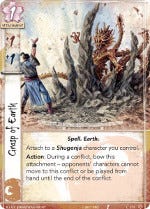
Grasp of the Earth is a 1-fate cost attachment that gives +1 military and +1 political skill, and can only be attached to a Shugenja you control. During a conflict, you can bow the attachment to prevent your opponent from moving characters into the conflict, or from playing conflict characters from hand, until the conflict ends. Like many of the spell- and Shugenja-based cards we’ve seen, it does not require presence, and a bowed Shugenja outside the conflict can use the card’s action. As Grasp must be in play before it can be used, your opponent will be forewarned. That said, even when Grasp of Earth is telegraphed it forces your opponent to play around it.

Initial testing with Kuroi Mori saw it used as the stronghold province in every game. The ability to switch between conflict types allows the Phoenix to choose whichever their opponent is weakest at. This can force a Lion deck to win a political conflict, or a crane deck to win a military conflict. Meanwhile, the Phoenix cards remain well balanced between both types. Alternatively, the Phoenix player has the option of changing the ring type. This gives more control over the ring being currently contested, allowing ring-dependent abilities to activate. Unlike the neutral provinces with similar effects which are reactions to the province being revealed, Kuroi Mori is an action which can be taken once per turn. This will make taking the last province from a Phoenix player incredibly difficult.
Glory and Honor
Phoenix characters have some of the highest glory characters we’ve seen so far. Their stronghold ability can push those values beyond anything the other clans could imagine. This gives the Phoenix an incentive to honor their own characters to gain the skill benefit from such high glory.

The Serene Warrior is simple and to the point: 3 fate for a 3 military-, 2 political-skill Bushi with 4 glory. No ability, but 4 glory is the highest we’ve seen yet. This makes honoring the Warrior a priority, pushing him to a 7/6, which compares favorably with clan champion numbers. His 4 glory quickly makes him immune to one of the best defensive cards in the game, Mirumoto’s Fury, and he can potentially be honored and attacking turn one. On the other hand, if the Warrior is dishonored he becomes a 0/0 character.

The Asako Diplomat is the first Phoenix Clan dynasty Courtier we get to see. For 2 fate, the Diplomat gives you 1 military skill, 2 political skill, and 1 glory. However, the focus here is on her ability. When the Diplomat wins a conflict, you get to either honor or dishonor a character, an effect identical to the Ring of Fire. This ability can be used each turn, and with the Phoenix Clan’s high glory values and their stronghold ability, the Diplomat can rapidly create an overwhelming volume of stats. In addition, her honoring and dishonoring of characters will provide additional fuel for any honor or dishonor strategy her player might adopt.
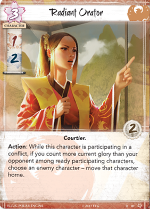
The Radiant Orator is second of the Phoenix Clan’s dynasty Courtiers. Her ability is a send-home effect, which can only be used if you have more total glory than your opponent among ready participating characters in a conflict. With the stronghold ability and high glory of the Phoenix, this is pretty reliable. The effect sends an enemy character home. It doesn’t bow them, but it does remove them from the conflict. If this is not their controller’s last conflict, it means the sent-home character can assign to another conflict. If it is their controller’s last conflict, then that character will contribute toward their controller’s bid for the imperial favor. On the other hand, removing a character from a conflict will stop an ability that requires that character’s participation, and characters that are focused on one conflict type are likely to be much less effective in the other – if they can even participate at all.
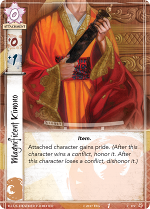
Magnificent Kimono is free! This immediately pushes this card up the priority list. For 0 fate, you gain an attachment that gives +1 political skill and gives the character Pride. Pride is another keyword, which reads:“After this character wins a conflict, honor it. After this character loses a conflict, dishonor it.”. With many provinces having a strength of 3 or 4, the +1 political skill can be surprisingly relevant when it comes to breaking, with the honoring from Pride as an additional and possibly very significant benefit. You can also attach a Magnificent Kimono to an enemy character who is about to lose a conflict, as a way to dishonor them. (Beware of sneaky Phoenixses, Precious. We hates them, Precious. Hates them!)
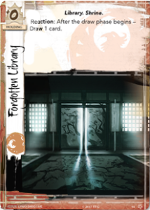
Forgotten Temple is the Phoenix clan holding, it has no province strength bonus but does have a pretty great ability. In reaction to the start of the draw phase, draw a card. This access to easy card draw will allow the Phoenix to bid less during the card draw phase to focus on winning by honor.
Shugenja and Bushi
In the dynasty deck, the Phoenix have 5 Shugenja, providing a solid base for cards such as Cloud the Mind and Grasp of Earth. They also have 4 Bushi, including the Clan champion. These Bushi typically seem to possess efficient stats but no abilities, like the Serene Warrior or Shiba Peacemaker. They provide the raw skill to win conflicts, while the Shugenja of the clan clear the way.

The Shiba Yōjimbō continues the time-honored Phoenix theme of Shiba Bushi protecting Isawa Shugenja. The Yōjimbō’s interrupt will cancel the effects of any triggered ability that targets a Shugenja you control. A triggered ability is one with a colon, so an Action: or Reaction: from a card in play, or one played from hand. The Shiba can still be targeted first, and her ability will only work once per turn, but just having a Shiba Yōjimbō in play will stop an effect targeting one of your Shugenja, even if the Yōjimbō is bowed and outside the conflict.
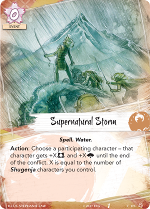
Supernatural Storm is an event that gives one of your characters in a conflict a military and political skill boost equal to the number of Shugenja characters you control. It can be played on attack or defence, and has no target limitations. With Banzai!, Court Games (which is better for Phoenix than any other clan, due to the stronghold ability), and now Supernatural Storm, the Phoenix have access to a lot of skill boosts, allowing them to break provinces even with seemingly innocuous attacks.
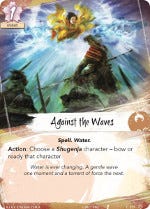
Against the Waves is a 1 cost event card that will bow or ready a target Shugenja. In most games, this is going to let the Phoenix get an extra use out of a Shugenja character. Isawa Masahiro can bow for his action and unbow to contribute his skill to the conflict. You can also unbow a Shugenja character after a conflict to ready them for a second conflict. Alternatively, you can target an enemy Shugenja, such as Togashi Yokuni and bow them preventing them from assigning to a conflict.

The Clan Champion
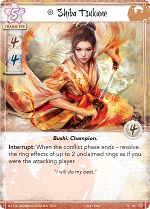
Shiba Tsukune is a balanced 4 military and 4 political skill Bushi. Her 4 glory is the highest of any clan champion we have seen (and with only Unicorn and Scorpion to come, that’s not likely to change). When honored, she becomes an 8/8, but when dishonored, she becomes a 0/0. This provides a strong incentive to get Tsukune honored as early as possible. Even at 0/0, however, she still exerts a significant influence over the game, thanks to her ability. After the conflict phase ends, you can resolve the effects of up to two unclaimed rings as though you were the attacking player. While it is possible that four rings can be claimed in a turn, often two to three rings remained unclaimed, giving her ability plenty to work with. Combined with the ring manipulation of the Phoenix, this could see strange scenarios like the same ring being triggered three or four times in a turn. And even in cases where sub-optimal rings remain, Shiba Tsukune will still provide incremental benefits that can accumulate to something more meaningful the longer she stays in play.
Tsukune also removes the Phoenix Clan’s need to attack, allowing them to turn everything toward defence. If an opponent is resolving zero or one rings a turn, and a Phoenix Clan player is resolving three or even four, that opponent will quickly find themselves in an unmanageable position. And when combined with the Phoenix Clan’s other ring manipulation abilities, Tsukune can passively force opponents into catastrophic situations, where seemingly necessary lines of play become game-losing traps.
Summary
Overall, the Phoenix are a clan of situations. Their abilities are often unreliable, or dependent on certain conditions being met. When those conditions are not met, the Phoenix will likely fold, and with somewhat pitiful resistance. However, when their cards fall into place, many opponents will simply not be able to handle what the Phoenix deal out. Underlying all of this is arguably the lowest-floor, highest-ceiling skill requirement of any clan to date. With the Phoenix, it will be absolutely essential to read the game a turn or two ahead, and to envision and repeatedly revise how the game is going to play out. Knowing when to manipulate the rings is going to be far more important than the ability to simply do so. With so much added complexity and unreliability, the Phoenix may not be the strongest out of the gates, but they have some key ingredients for dominating play – explosiveness, powerful reversals, and the manipulation of a core mechanic.
And as a Phoenix player, remember – if everything goes wrong, just take off and nuke the entire site from orbit. It’s the only way to be sure.
he Phoenix have five conflict cards that only require 1 influence; Grasp of Earth, Magnificent Kimono, Seeker of Knowledge, Against the Waves, and Supernatural Storm. Grasp of Earth, Supernatural Storm, and Against the Storm all require Shugenja to be useful and are going to be difficult for most clans to play. Magnificent Kimono is a great tool to honor or dishonor characters while Seeker of Knowledge is a great way to trigger Air. Both cards are good for decks with honor or dishonor strategies.
Two of the cards require 2 influence, Pacifism and Ishiken Initiate. The Initiate provides skill, and as such is a worthwhile addition to any deck but is unlikely to be a primary draw. Pacifism is a good control card, although it is a little expensive at 2 cost. The remaining two cards are Know the World and Display of Power both at 3 influence. These are the ‘meddling with the elements rings’ cards and would be of great interest to any clan. The super popular splash for other clans from the Phoenix is Display of Power and Magnificent Kimono.

Influence from other clans
Crab: Reprieve is always a good addition and only costs 1 influence. To improve the military potential, options such as the Hiruma Ambusher and Stoic Gunso, both at one influence, are a good addition. The Mountain Does Not Fall is a little more expensive at 3 influence, but would allow an honored, high-glory character to participate in multiple conflicts. Suggested: 2 Reprieve, 2 Stoic Gunso, and 2 The Mountain Does Not Fall.
Crane: Due to the prevalence of honoring effects with the Phoenix, Voice of Honor and Noble Sacrifice are good options, both at 2 influence. Steward of Law could provide an extra Courtier to gain access to Courtier-specific cards, and can also provide dishonor protection for those high-glory characters. Admit Defeat is a bow action during a conflict which can be very effective if your opponent has only one defender. Suggested: 2 Voice of Honor, 2 Steward of Law, and 2 Admit Defeat.
Dragon: Let Go is always useful to destroy your opponent’s attachments, importantly Cloud the Mind which can neutralise some of your powerful character abilities. Mirumoto’s Fury helps defend without needing to assign defenders, which helps with Display of Power. Tattooed Wanderer gives an additional covert option, together with Pacifism and Adept of the Waves limiting your opponent’s ability to defend. Kitsuki’s Method and Ancestral Daishō also get the job done. Suggested: 3 Mirumoto’s Fury and 2 Let Go.
Lion: Stand Your Ground can be used to keep honored characters in play. Honored Blade gives some extra military skill and pushes towards an honor win. Ready for Battle is always great against the many bow effects in the core set. Sashimono could be useful, but the Bushi restriction could make it tricky to reliably play. Strength in Numbers is a great card for removing defenders helping break provinces and dishonor through undefended provinces. Suggested: 3x Honored Blade, 2x Stand Your Ground, 3x Ready for Battle .
Scorpion: The big card from the Scorpion pool is Forged Edict and Phoenix certainly have the Courtiers needed to run it. However, unlike Scorpion the Phoenix tend to have high glory which makes the dishonoring cost tricky. The Edicts are a good way to protect the high impact cards like Display of Power which otherwise might get cancelled by an opponents counter. After that, there are some interesting options like Adept of Shadows, Calling in Favors, and Court Mask but nothing at the same power level as Forged Edict. Suggested: 3x Forged Edict, 2x Calling in Favors
Unicorn: Everyone loves Spyglass, being able to draw more cards is something without a downside. After that Iuchi Wayfinder and Favored Mount seem to be the best options for consideration. The Iuchi Wayfinder is just generally useful as a cheap 1/1 with a bonus ability. The Favored Mount can be used in combination with Spyglass to get another card, but it also gets characters like Asako Diplomat, Fearsome Mystic, and Radiant Orator into a battle to trigger their ability. Suggested: 3x Spyglass, 2x Iuchi Wayfinder, 2x Favored Mount.
Sample Decklist
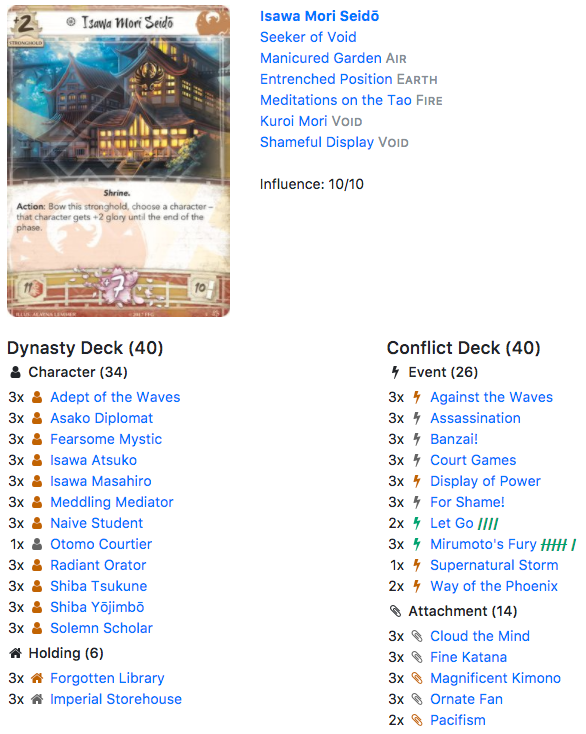
Justin discusses his reasons behind this decklist on our YouTube channel.
Next up we have the Unicorn
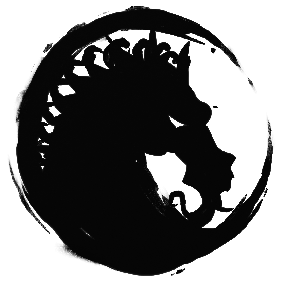
If you have any comments or feedback please post them in the comments section below.
Join us on our Twitch stream on Monday the 31st July at 8pm BST, 9pm CEST, 1pm PST. We will be talking about our experiences with the Phoenix. As always we will be answering any questions from those who make the stream.
Check us out on the Imperial Advisor website, podcast, and YouTube channel for more discussion about the L5R LCG.
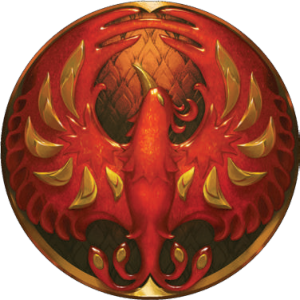
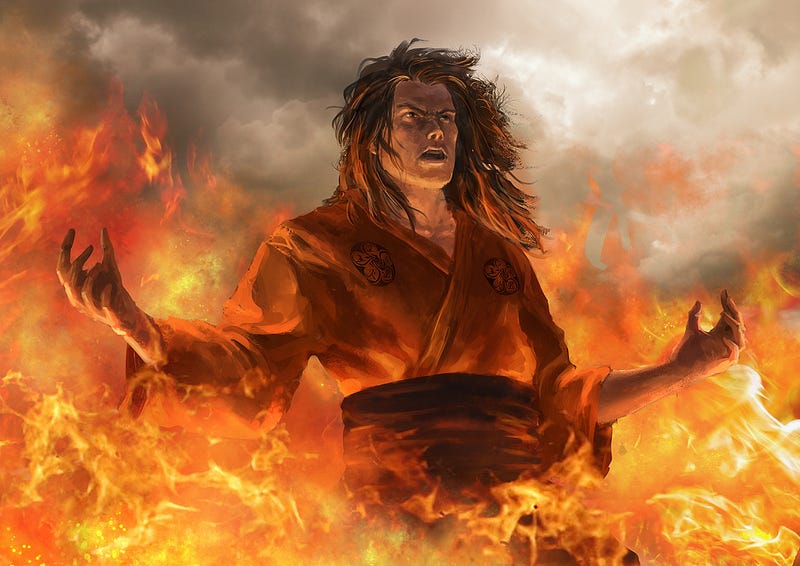

 Bazleebub
Bazleebub
5 Replies to “Clan Focus – The Phoenix”
Ok I have played 2 games as Phoenix with Crane splash Voice of Honor and Noble Sacrifice versus Dragon. Now my experience was I played only one Voice out of 2 games and I drew and held them in both games. They were just dead cards in hand. Now again I didn’t see any Asako Diplomats in either game either. But I did draw Court Games fine. It seems the Phoenix cannot reliably honor more than one here and there. Not enough to run those splash. If your opponent denies you the fire ring it can hurt. The Kimono is good but it is only good on someone with fate. It doesn’t help you win a conflict. It is an investment later. So you have to win conflicts with the Kimono, Asako Diplomat, and the Fire Ring to get honored. The trick is getting on that positive side. I think keeping Phoenix on the ropes will be key to beating them. To that end, I think Phoenix has to drop some of the ring tricks and play more “win conflict” cards. Less Know the World and maybe not 3 Way of the Phoenix, and run Rout and For Shame! that you didn’t have room for in your deck. Even Display of Power might only need 2. After you lose 2 provinces, not defending a 3rd doesn’t look like much of an option.
Going back to splash, I am thinking after Crane not working so well that I agree Dragon would be good. Mirumoto’s Fury is amazing. Let Go helps remove pumps so that wins fights. The Tattooed Wanderer is good too. Otherwise I think Lion to counter For Shame! And Mirumoto’s Fury with Ready For Battle and Honored Blade for more pump.
Just my thoughts after playing them.
Awesome feedback, there really is nothing like actually getting some games in. I fully expect to be revising / completely rewriting this set of articles down the line once we have more games in.
Your experience with the Crane splash is interesting. Crane also have limited ways to honour their personalities with the real difference being the ease that Way of the Crane offers. Its surprising, but not shocking, how much of a difference that one card makes. Phoenix honouring effects, as you say, also seem to be more reliant on winning. So to boost to win you need to win so you can boost so you can…
I’ve also had some feedback from other games that Display of Power is problematic. It’s very situational so getting to play it can be difficult, then once you’re down to your last Province it’s useless.
I’m enjoying the way FFG have approached influence. I’m expecting clans will be shifting through a few options in the core set in reaction to whatever clans end up being dominant in the environment.
Updated with Against the Waves.
Love the article. Hoping for a sample decklist soon as well as an update on possible Scorpion and Unicorn influence possibilities.
Good news! In our most recent show which is up on Twitch (soon on YouTube) Justin covered his current Phoenix deck. I’ll be updating this article to add in his deck and links and hopefully do a bit of tidy up this week.